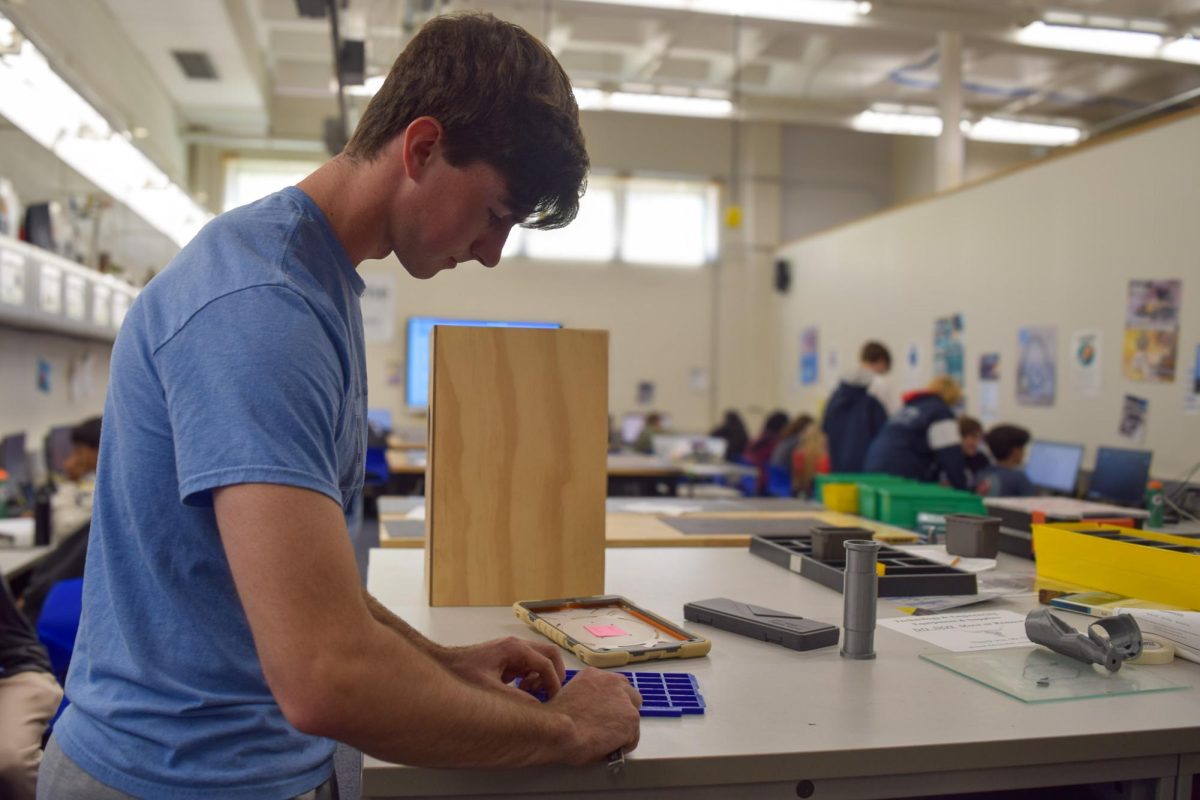Getting a driver’s license is one of the most exciting moments for a teen. The possibilities are endless with the keys to freedom and the family car. However, one of the most important indicators of independence is signing the lease to your first house. These keys unlock a plethora of responsibilities: something Latin teacher Tom Herpel learned several years ago.
When Herpel bought his first house, he realized there was much to be done. So he started developing his woodworking skills as a cost-effective way to do repairs. At first, he made several everyday objects to turn the house into a home.
“There was so much stuff that needed to be fixed. When I was in my apartment I didn’t have a garage to work with wood,” Herpel said. “For my house, the first thing I made was a wooden bench. Then after that, it was just little things. I made a few wood boxes, and then I built my children’s furniture. Not the crib, but things like the changing table, bookshelves and the lampstand.”
Herpel turned to the internet and magazines to learn more about the craft. He has found woodworking magazines especially helpful and exciting, with ideas for future projects to fill the house with. He also fields requests from friends and family.
“I sound like such an old fart, but [woodworking magazines] have a lot of cool tips and details on how to build things. They also show all these cool things that really good artisan carpenters make. I would love to make some of those things. My kids also want me to build them a treehouse. For my sister’s wedding, I made a box for guests to slot their names in. The finished product made a heart and was pretty cool,” Herpel said.
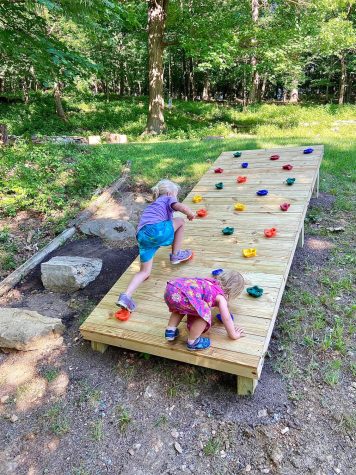
When Herpel got power tools to help with his projects, woodworking progressed from something done out of necessity to a mental escape.
“I like the idea that tools give me so many ways to do the same thing,” Herpel said. “For instance, I’m making a wooden box out of a block of wood. There are so many different ways you can hollow out the wood, depending on what tools you have. I’ve gone through test scraps and tried two or three different ways to do it. The problem-solving process and trial-and-error make it much more rewarding when you finish the actual product.”
According to Herpel, one aspect of problem-solving is creativity and flexibility. For example, when the Parkway administration banned extra furniture in classrooms, Herpel repurposed a former classroom couch, which he built himself. This decision was shaped by the exponential increase in lumber prices due to COVID-era supply chains.
“The wooden couch in my room became a cash cow of material,” Herpel said. “After taking the couch apart in my classroom [because] it wouldn’t fit through the door and transporting the wood home, I built a climbing wall for a hillside in [my] backyard. My kids absolutely loved it.”
Through critical thinking, Herpel feels he has developed more patience. For example, he recalls one project, a wooden matrix, that he wanted to decorate one of his kids’ rooms. The product was different from what he had built prior and called for trial-and-error.
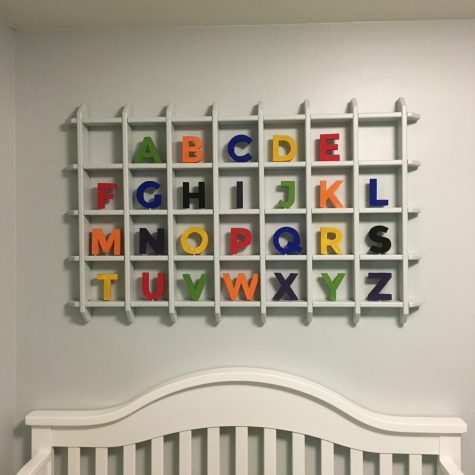
Herpel has invested in extra safety measures to counter the risks of the machinery. For example, to protect himself when cutting wood, Herpel uses a SawStop, a special table saw that brakes when it senses skin contact. He was urged to get one by his wife and father-in-law, who know people that have gotten severe injuries doing woodwork.
“My wife is a nurse anesthetist– her dad was one too. He used to tell stories about doctors at his workplace that were trying to build stuff and then cut off their fingers– and there goes their profession. So, both her and her dad convinced me to get a SawStop. It’s saved my finger. Once, I was sawing a piece of wood, hit a knot [in the wood], and the wood turned sideways, so my hand went straight toward the saw. I didn’t even have a cut on my finger, but it would have cut my finger square off [without the SawStop],” Herpel said.
As Herpel continues to hone his technical skills and challenge himself, he hopes to learn enough about woodwork to make a desk from a tree he cuts down himself.
“During my first year teaching, the icebreaker I had for my class was ‘what’s on your bucket list?’ The first thing on my list was to cut down a tree, dry out the wood, slice the wood into boards and turn it into a desk. Realistically, I don’t even know how to do that. Drying slabs of wood requires a certain humidity [to avoid cracks and warping]. I would probably cut down a tree and throw it in my garage. And I don’t think that’s the right thing to do. But that’s my dream,” Herpel said.
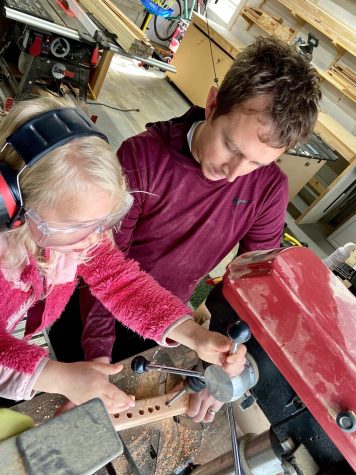


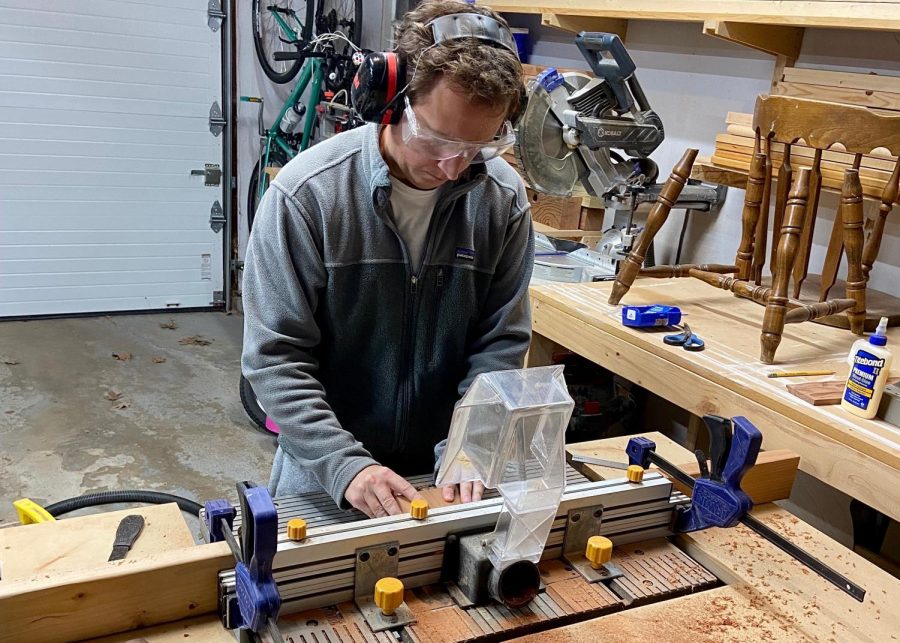
![Focused on providing exceptional service, sophomore Darsh Mahapatra carefully cleans the door of a customer’s car. Mahapatra has always believed his customers deserve nothing less than the best. “[If] they’re trusting us with their car and our service, then I am convinced that they deserve our 100 percent effort and beyond,” Mahapatra said.](https://pwestpathfinder.com/wp-content/uploads/2025/10/DSC_0018-1200x800.jpg)
![Sophomore Aleix Pi de Cabanyes Navarro (left) finishes up a soccer game while junior Ava Muench (right) warms up for cross country practice. The two came to Parkway West High School as exchange students for the 2025-2026 school year. “The goal for the [exchange] program is to provide opportunities for both Parkway students and our international exchange students to learn about other cultures, build connections and become confident, capable, curious and caring — Parkway’s Four C’s — in the process,” Exchange Program Lead Lauren Farrelly said.](https://pwestpathfinder.com/wp-content/uploads/2025/10/Feature-Photo-1200x800.png)

![Gazing across the stage, sophomore Alexis Monteleone performs in the school theater. The Monteleone family’s band “Monte and the Machine” has been releasing music since 2012, but Alexis started her own solo career in 2024 with the release of her first single, Crying Skies. “My whole family is very musical, [and I especially] love writing [songs with them],” Monteleone said.](https://pwestpathfinder.com/wp-content/uploads/2025/09/DSC7463-1200x798.jpg)
![Amid teaching a lesson to her AP Calculus BC class, Kristin Judd jokes alongside her students in their funny remarks. Judd has always enjoyed keeping the mood light in her classroom, along with on the volleyball court. “[I enjoy] that side talk where you see [or] overhear a conversation and chime in, or somebody says something funny,” Judd said.](https://pwestpathfinder.com/wp-content/uploads/2025/09/image-1200x730.jpg)
![Eyeing the ball, junior Ella McNeal poses for her commitment pictures at Clemson University. McNeal’s commitment comes after months of contact with top Division 1 soccer programs. “ It has taken a lot to get to where I am, but I know that [what] I've already been through is just the beginning, and I can't wait for what is to come,” McNeal said.](https://pwestpathfinder.com/wp-content/uploads/2025/09/IMG_4926-1200x900.jpeg)


![Senior Adam Zerega stands with senior Dexter Brooks by farm equipment. Zerega often worked with friends and family on his farm. “I've been able to go to my family's farm since I was born. I [spend] at least three weekends a month [on the farm], so I'm there all the time,” Zerega said.](https://pwestpathfinder.com/wp-content/uploads/2025/04/IMG_4872-1200x900.jpg)
